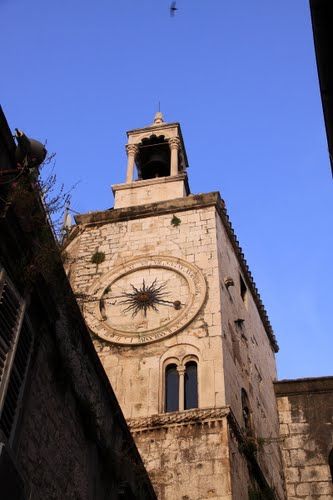Sites in Split: Pjaca
Narodni Trj (People’s Square), known as Pjaca (a Croatian interpretation of the Italian ‘Piazza’) by locals was once called San Lorenzo’s Square (Trg svetog Lovre). It is located just past the western walls of Diocletian’s palace at the exit of the Iron Gate. As the population grew, the palace became too small and Pjaca was the first area developed beyond the walls in the 14th century.
Just as you exit the Iron Gate, an interesting tower-like house is topped with gothic bell-tower. It has a little Romanesque opening and a grand clock on its façade. The clock is captivating as it is divided into 24 parts instead of 12.

Image from panoramio.com
Passing the clock tower is the Palace of Cipriano de Ciprianis on the Southeastern corner of Pjaca. It is a late-Romanesque structure built by an aristocrat from the island of Korčula in the late 14th century. It is characterized by its heksaforas, six-part windows on the first floor separated by double columns. On its façade is a statue of St. Anthony.

Image from members.virtualtourist.com
Previously, Pjaca got its role as the center of the municipal government and thus, its main attraction today is the old Town Hall. This 15th century gothic structure is accented by three gothic arches, which are supported by two columns with capitals. Today is no longer serves as a public office but as a function space with many exhibitions.

Image from panoramio.com
Connected to the old Town Hall by Late Gothic double windows is the charming little Karepič Palace. It is built in the 16th century and follows the High Renaissance style.
At the far end of the square is the newer and grand Nakić Palace from 1902. It is a magnificent example of the Art Nouveau style with round corners and floral ornamentation, taking inspiration from Viennese Secession architecture.

Image from panoramio.com
Pjaca is a popular meeting spot for elderly gentlemen who meet for a morning coffee and gossip in the Gradska Kavana café. A sit on this square provides the perfect vantage point to life passing by. There are several cafes taking up seats on the square, an old bookshop, shoe shops, fashion stores and luxury apartment accommodation. There is also a flagpole monument called Standarac.
No Stress Cafe and Bistro: Going Urban Chique on Pjaca
Located right next to the 15th century City Hall on the famous Pjaca (Narodni Trg), the urban chique décor of this al fresco café and bistro definitely draws curiosity; it positively drew mine… three times in one! This is a popular coffee spot for the city's elite and intellectuals for a morning chat as they observe who is striding across Pjaca in the latest fashion but as the sun starts to get, hip youth swarm to this joint to be seen on this popular square.

When the weather warms, an Istrian super-chef conquers the kitchen as he stirs up a selection of contemporary Croatian dishes crafted with premium ingredients. During one of my late summer nights, the chef started me off with a trio of seafood tartar; sea bream on bob beans, wasabi tuna on diced tomatoes, and shrimp on truffle cream cheese.

Moving on, I opted for the flavorsome beef fillet steak with aromatized potatoes, creamy truffle sauce and saffron.

With a constantly rotating dessert menu, I was served with a favorite creation of mascarpone cantuccini scoops with a wild berry sauce.
No Stress is also known to serve simple breakfasts during the season.
Sit back and don’t stress as you flavor local specialties at another dimension. This al fresco venue provides you with front row seats to Laganini, a Dalmatian expression defining their slow and laid back attitude to life.
Address: Iza lože 9, 21000 Split, Croatia

